Hemorrhoids or Piles Treatment
The term ‘hemorrhoid or piles’ comes from the Greek and means ‘flowing blood’ and this is something not normal. Despite this, many specialized books erroneously refer to hemorrhoids as a normal part of the anatomy and this is far from the truth. Haemorrhoids are a disease of the anal cushions that consist of clusters of connective tissue, smooth muscle, and vascular structures covered by mucosa and arranged in the typically described position of 3,7,11 o’clock in the anal canal. Their function is to contribute to the anal continence at rest. Internal hemorrhoids are situated above the dentate line and are supplied by the internal hemorrhoidal plexus that is a dependence of the superior rectal vessels. External hemorrhoids are situated below the dentate line and are supplied by the external hemorrhoidal plexus that is formed by the inferior rectal vessels. These two plexuses have some communications (A-V shunts) that are usually closed in normal circumstances. In haemorrhoidal disease, these shunts sometimes open up and an internal hemorrhoid is seen to continue with external hemorrhoids without distinct separation between them. We refer to this situation as ‘internal-external hemorrhoid’. Internal hemorrhoids have visceral innervation while external hemorrhoids have somatic innervation. Д-р Антонио Привитера is a world-renowned surgeon and is a piles or hemorrhoids doctors in Dubai, Abu Dhabi and Al Ain.
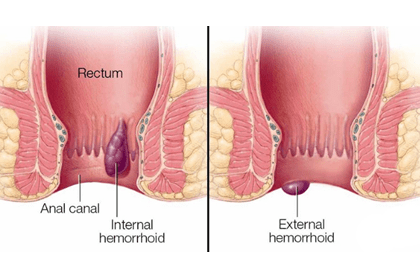
About Hemorrhoids or Piles
Распространенность геморроя в Соединенных Штатах Америки составляет около 4-8%. Геморрой выявляется до 38% скрининговых колоноскопий, однако только в 44% случаев он протекает бессимптомно. Основными факторами риска являются возраст старше 45 лет и ожирение.
Традиционно внутренний геморрой подразделяется на 4 степени. Геморроидальные узлы I степени видны при аноскопии как выпячивание в анальном канале, но без пролапса. Геморроидальные узлы II степени выпячиваются при напряжении, но самопроизвольно уменьшаются. Геморроидальные узлы III степени пролабируют и требуют ручного вправления. Геморрой IV степени характеризуется постоянным выпадением геморроидальных узлов за пределы ануса с частым наличием фиброзных изменений и кожных меток.
Causes of Hemorrhoids or Piles
Есть несколько теорий, которые пытались объяснить происхождение геморроя. Диета с низким содержанием клетчатки приводит к запорам и чрезмерное усилие при дефекации долгое время считалось основным фактором риска. Это может объяснить более высокую заболеваемость в западных странах по сравнению, например, с африканскими странами. Поза во время дефекации, по-видимому, также играет важную роль. В обществах, которые следовали западным привычкам, сидячее положение во время дефекации приводит к более острому аноректальному углу с, как следствие, большей нагрузкой на анальный канал. Натяжение может привести к растяжению и структурным изменениям анальных подушек с уменьшением венозного оттока и открытием артериовенозных анастомозов, создающих систему высокого венозного давления. Этому механизму способствует общая дряблость тканей. Геморрой был описан у пациентов с синдромом Элерса-Данлоса, что позволяет предположить, что аномалия коллагена может быть предрасполагающим фактором. У больных геморроем наблюдается увеличение количества матриксных металлопротеиназ, которые регулируют внеклеточные белки и ремоделирование тканей.
В других исследованиях была выявлена связь с диареей, а не с запорами. Диарея сама по себе создает нагрузку на анальный канал, так как пациенту приходится опорожнять кишечник несколько раз в день.
Symptoms of Hemorrhoids or Piles
Внутренний геморрой чаще всего проявляется безболезненным ректальным кровотечением и/или выпадением. Пролапс может приводить к загрязнению, слизистым выделениям и раздражению кожи. Болезненные внутренние геморроидальные узлы обычно являются следствием тромбоза, инкарцерации и ущемления. Осложненные наружные геморроидальные узлы часто бывают очень болезненными из-за их соматической иннервации. Это может произойти в случае образования гематомы или тромбоза внутри геморроидальных узлов. Когда тромб рассасывается, в результате воспалительной реакции и заживления могут остаться кожные метки. Они могут вызывать раздражение и создавать проблемы с гигиеной.
Симптомы геморроя часто проходят сами собой и хорошо поддаются консервативным мерам: изменение рациона питания с увеличением потребления жидкости и клетчатки, слабительные средства, регулярные физические упражнения, избегание запоров и напряжений, изменение привычек туалета.
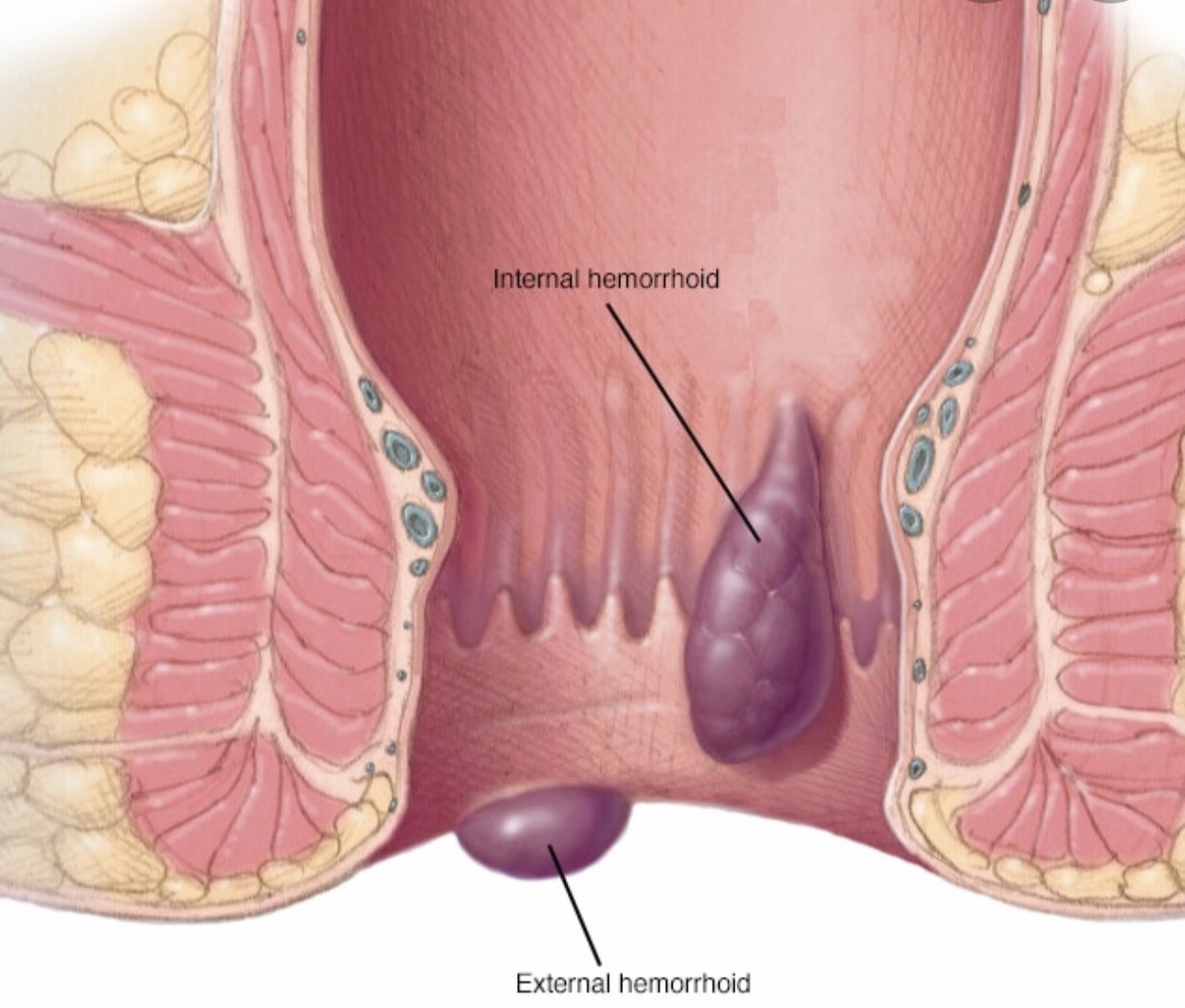
Diagnosis of Hemorrhoids or Piles
Диагностика геморроя основывается на данных анамнеза и осмотра. Очень важно не связывать ректальное кровотечение с геморроидальной болезнью до проведения полного обследования. Аноскопия и жесткая проктоскопия могут быть легко выполнены в клинике. Гибкая сигмоидоскопия или полная колоноскопия могут быть проведены в каждом конкретном случае.
Treatments for Hemorrhoids or Piles
- Hemorrhoids treatment with fiber supplementation has been shown to decrease rectal bleeding by 50%, however, it seems to have little impact on prolapse, pain, and itching. There is no evidence to support the benefit of steroid and local anesthetic topical over-the-counter medications.
- Phlebotonics are a class of medications that have the property to increase venous tone, stabilize the permeability of capillaries, and improve lymphatic drainage. A Cochrane review has shown that hemorrhoids treatment with phlebotomids compared to control groups improve bleeding, itching, discharge, and leakage. Mild gastrointestinal side effects are reported.
Methods of Hemorrhoids or Piles Surgery
Хирургическое лечение геморроя включает как офисные процедуры, не требующие анестезии, так и процедуры, выполняемые под местной, региональной, спинальной или общей анестезией. Выбор метода лечения зависит от степени тяжести геморроя и сопутствующих симптомов. Безболезненное лечение геморроя может быть достигнуто с помощью новых методик, которые связаны лишь с легким дискомфортом.
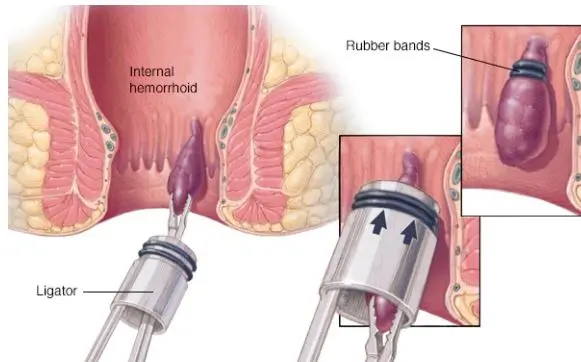
Лигирование резиновой лентой
Rubber band ligation is the most commonly performed procedure in the outpatient department for Grade I and Grade II hemorrhoids or piles. It can also be used for Grade III, but the risk of recurrence is high, and usually, more sessions are required. Suction devices are most often used.
Обычно ленту накладывают чуть выше внутренних геморроидальных узлов, чтобы прервать кровоснабжение и вызвать ишемию, слущивание, последующее изъязвление и заживление в течение нескольких недель. При наложении ленты выше зубчатой линии, где имеется висцеральная иннервация, обычно ощущается тупой дискомфорт. К осложнениям относятся сильная боль (связанная с неправильным расположением ленты или тромбозом), задержка мочи, задержка ректального кровотечения, редко - сепсис. Общий процент успешных операций составляет около 70%.
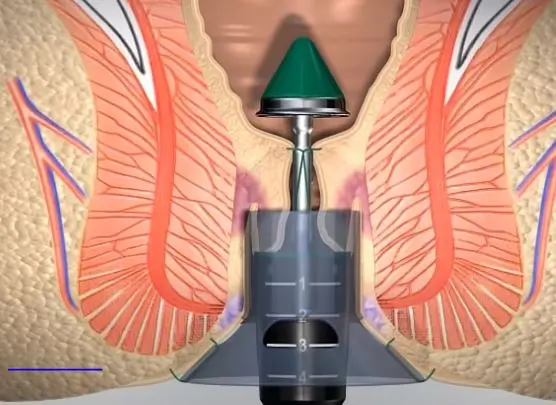
Сшивная геморроидопексия
Stapled hemorrhoidopexy is based on the concept of removing part of the lower rectal mucosa to lift the hemorrhoids and cut off the blood supply. The resulting staple line must be away from the dentate line to avoid severe postoperative pain. Usually, this is around 4 cm from the anal verge. Circumferential Grade III hemorrhoids are the ideal indication for this kind of procedure that has the advantage of reduced postoperative pain.
However, surgeons must have sufficient training on the stapling device to avoid rare but possibly described specific complications including recto-vaginal fistula, stenosis, perforation, and anal sphincter injury. Studies have shown that long-term results are better with excisional hemorrhoidectomy than hemorrhoidopexy.
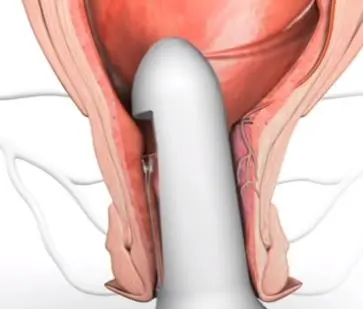
Допплерографическое лигирование геморроидальных артерий
При допплерографическом лигировании геморроидальных артерий используется специальный проктоскоп с допплеровским датчиком, который позволяет выявить и перевязать ветви верхней прямокишечной артерии, питающие геморроидальные узлы. Также выполняется мукопексия для пликации сопутствующего выпадения слизистой оболочки прямой кишки.
Геморроидэктомия
Геморроидэктомия подразумевает хирургическое иссечение геморроидальных узлов и дает наилучшие долгосрочные результаты, но в то же время характеризуется повышенным числом осложнений и болевым синдромом. На коже вблизи анального отверстия делается эллиптический разрез, геморроидальный столб отсекается от внутреннего сфинктера и разделяется его ножка. Это очень важный этап операции, так как повреждение внутреннего сфинктера может привести к недержанию мочи. Кроме того, необходимо сохранить мостики интактной слизистой оболочки для предотвращения стеноза анального канала. Раневой дефект может быть оставлен открытым для заживления (техника Миллигана-Моргана) или закрыт швами (техника Фергюсона). Послеоперационная боль может быть сильной в первые несколько дней, поэтому были разработаны многочисленные миниинвазивные методики.
Laser Hemorrhoids or Piles Treatment
Лазерное лечение геморроя - это метод, при котором происходит уменьшение геморроидальных узлов за счет введения лазерного зонда в геморроидальную ткань. Необходимо следить за тем, чтобы зонд не был направлен на внутренний анальный сфинктер, а также прикладывать лед после каждого воздействия для уменьшения теплового повреждения. Также выполняется мукопексия. Болевые ощущения меньше, чем при традиционной геморроидэктомии.
Склеротерапия
Инфракрасная коагуляция
Emergency Hemorrhoids or Piles Surgery
Emergency surgery for internal hemorrhoids should only be performed in case of strangulation or inability to reduce incarcerated hemorrhoids caused by prolapse with anal sphincter spasm. Most of the time emergency reduction can be obtained after the application of sugar or salt to reduce edema. Thrombosed external hemorrhoids are usually severely painful in the first 48-72 hours. Subsequently, the pain subsides as the hematoma is reabsorbed. Conservative measures with fiber supplements, laxatives, and local anesthetic are usually adopted. Unroofing of external hemorrhoids and evacuation of the clot or full excision is indicated in cases of severe pain non-responding to analgesia and case of recurrent symptoms.
Hemorrhoids or Piles Doctor in Dubai, Abu Dhabi and Al Ain
Most surgeons and some physicians commonly perform hemorrhoids treatment in Dubai and Abu Dhabi. However, patients must be aware that the best results of hemorrhoids treatment in Dubai and Abu Dhabi are achieved by colorectal surgeons who have a full understanding of the anatomy, and they are skilled with the various techniques and able to tailor treatment to each individual. Problems that may arise from improper treatment include fecal incontinence and severe long-lasting pain that severely impair the quality of life. People would generally search on internet search engines for a “Hemorrhoids or Piles Doctors in Dubai and Abu Dhabi” and be confused by the many clinics and hospitals offering a vast array of options. A hemorrhoids treatment doctor in Dubai and Abu Dhabi should be a colorectal surgeon with reputable fellowship training, a member of colorectal societies, and with a dedicated history of practice in the field. A hemorrhoids treatment doctor in Dubai and Abu Dhabi should well know when not to operate and how to best resolve the patient’s symptoms. In the absence of prolapse, a hemorrhoids doctor should not perform a stapled hemorrhoidopexy. Any hemorrhoids treatment doctor in Dubai and Abu Dhabi should know that there is no point in treating surgically thrombosed external hemorrhoids after 72 hours. The hemorrhoids treatment doctor in Dubai, Abu Dhabi and Al Ain should consider a formal hemorrhoidectomy for Grade IV hemorrhoids, especially when fibrotic changes and multiple skin tags are present.
Haemorrhoids or Piles FAQs
Do I need treatment, or do haemorrhoids (piles) typically resolve on their own?
Hemorrhoids, or piles, can sometimes resolve on their own, especially if they are small and not causing significant symptoms. However, this varies widely among individuals. For persistent or worsening symptoms such as pain, itching, or bleeding, treatment is often recommended to alleviate discomfort and promote healing. Conservative measures such as dietary modifications to increase fiber intake, topical treatments (creams, ointments), and sitz baths can help manage symptoms effectively. In more severe cases, procedures like rubber band ligation, sclerotherapy, or surgery may be necessary to fully resolve hemorrhoids. It’s advisable to consult with a healthcare provider to determine the most appropriate treatment based on the severity and persistence of your symptoms.
How does exercise benefit my hemorrhoids?
Exercise benefits hemorrhoids in several ways. Regular physical activity improves blood circulation throughout the body, including the veins in the rectal area where hemorrhoids develop. Improved blood flow helps reduce swelling and inflammation of hemorrhoidal veins, which can alleviate symptoms such as pain, itching, and discomfort. Additionally, exercise promotes regular bowel movements by stimulating the muscles of the colon and rectum, which reduces the strain and pressure on hemorrhoids during defecation. Exercises that strengthen the pelvic floor muscles, such as Kegel exercises, can further support bowel function and reduce the risk of hemorrhoid formation or exacerbation. Overall, incorporating moderate aerobic activities like walking, swimming, or cycling into your routine can contribute to better digestive health and help manage hemorrhoid symptoms effectively.
Is there a definitive way to confirm if I have hemorrhoids (piles)?
Yes, there is a definitive way to confirm if you have hemorrhoids (piles). A healthcare provider can typically diagnose hemorrhoids through a combination of medical history and physical examination. During the examination, they may visually inspect the anal area for swollen blood vessels or perform a digital rectal examination to feel for internal hemorrhoids. In some cases, additional diagnostic procedures such as anoscopy or sigmoidoscopy may be recommended to further evaluate the extent and location of hemorrhoids. These tests allow the healthcare provider to confirm the presence of hemorrhoids and rule out other conditions with similar symptoms, ensuring accurate diagnosis and appropriate treatment.
I've had haemorrhoids in the past. Should I consider taking fiber supplements?
If you’ve had hemorrhoids in the past, considering fiber supplements may be beneficial. Fiber supplements, such as psyllium husk or methylcellulose, can help soften stools and make them easier to pass. This reduces the need for straining during bowel movements, which is a common trigger for hemorrhoids. Increasing fiber intake through supplements or dietary sources like fruits, vegetables, and whole grains can promote regular bowel movements and prevent constipation, thereby reducing the risk of hemorrhoid recurrence. It’s important to consult with a healthcare provider before starting fiber supplements to determine the appropriate type and dosage based on your individual needs and medical history.
Can surgery for haemorrhoids (piles) be avoided?
In many cases, surgery for hemorrhoids (piles) can be avoided through conservative treatments and lifestyle modifications. Initial management typically includes dietary changes to increase fiber intake, which helps soften stools and reduce straining during bowel movements. Over-the-counter medications such as topical creams or suppositories can provide relief from symptoms like pain and itching. Additionally, adopting good bowel habits, such as avoiding prolonged sitting and staying hydrated, can help alleviate symptoms and prevent hemorrhoid progression. Non-surgical procedures like rubber band ligation, sclerotherapy, or infrared coagulation are effective alternatives for treating persistent hemorrhoids without the need for surgery. However, for severe or recurrent hemorrhoids that do not respond to conservative measures, surgical intervention may be necessary. Consulting with a healthcare provider is crucial to determine the most appropriate treatment approach based on the severity and persistence of your symptoms.
Are ahemorrhoids (piles) potentially dangerous?
Hemorrhoids (piles) themselves are generally not considered dangerous, but they can cause significant discomfort and affect quality of life. Common symptoms include pain, itching, swelling, and bleeding during bowel movements. In some cases, hemorrhoids may become thrombosed (develop blood clots) or prolapsed (protrude outside the anus), which can lead to complications requiring medical intervention. Severe bleeding or persistent symptoms despite conservative treatment may indicate the need for further evaluation by a healthcare provider. While hemorrhoids are not life-threatening, complications such as severe bleeding or infection can occur, underscoring the importance of seeking medical attention if you have concerns or experience unusual symptoms associated with hemorrhoids.
Which treatment is best for hemorrhoids?
The best treatment for hemorrhoids depends on the severity of the condition and individual factors. Mild cases often respond well to conservative measures such as dietary changes to increase fiber intake, topical treatments (creams, ointments), and sitz baths. For more persistent or severe hemorrhoids, minimally invasive procedures like rubber band ligation, sclerotherapy, or infrared coagulation are effective options. These procedures help shrink hemorrhoidal tissue and alleviate symptoms without the need for surgery. In cases where hemorrhoids are large or do not respond to other treatments, surgical options such as hemorrhoidectomy may be considered. The choice of treatment should be tailored to each patient’s specific symptoms, preferences, and medical history, so consulting with a healthcare provider is essential to determine the most suitable approach.
Does insurance cover piles treatment in Dubai?
Insurance coverage for piles treatment in Dubai can vary depending on the insurance policy and provider. In general, many health insurance plans in Dubai cover treatments for medical conditions, including hemorrhoids (piles), especially if deemed medically necessary by a healthcare provider. However, coverage specifics, such as the types of treatments included, co-payments, deductibles, and network providers, may differ between insurance plans. It is advisable to check with your insurance provider directly to understand the extent of coverage for piles treatment, including consultations, procedures, medications, and any associated costs. This ensures clarity on what expenses are covered and any potential out-of-pocket costs you may incur.
Is it bad to leave haemorrhoids untreated?
Leaving haemorrhoids untreated can lead to worsening symptoms and potential complications. Hemorrhoids can cause persistent pain, itching, and discomfort, affecting daily life and quality of life. Without treatment, hemorrhoids may become more swollen, prolapsed (protrude outside the anus), or thrombosed (develop blood clots), which can increase pain and require more invasive treatment. Persistent bleeding from hemorrhoids can also lead to anemia over time if left untreated. It’s important to seek medical advice if you have symptoms of hemorrhoids to receive appropriate treatment and prevent complications. Early intervention with conservative measures or medical treatments can effectively manage symptoms and promote healing, reducing the need for more invasive procedures later on.
Looking for Hemorrhoids or Piles Doctors in Dubai, Abu Dhabi and Al Ain?
A proctology service not only for piles & hemorrhoids treatment but also for many other diseases is currently operating in Dubai London Hospital, Aster Hospital, American Hospital. Currently, Dr. Antonio Privitera is offering a free consultation for hemorrhoids or piles treatment in the same hospital in Dubai, Abu Dhabi and Al Ain.
